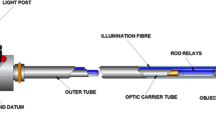Summary
Endoscopy evolved from a hollow tube view of visually restricted areas into an expansive, distal representation of the anatomy. Rod lens telescopes, improved coherent imaging bundles, superior light sources, and other optical advances enhanced endoscopic observations. Yet complicated endoscopic procedures remained visible to the endoscopist alone, relegating assistance and consultation toverbal description of sophisticatedvisual observation. Instrumentational advances alone did not promote three crucial elements:participation, cooperation and documentation. The importance of these elements has increased with the need for coordinated assistance in complex operative endoscopic manipulations, as well as in a visual record for improved documentation and consultation. New imaging technologies are supplanting the unwieldy, often daunting equipment once required for photodocumentation. The charged couple device (CCD) 2/3 and 1/2 in. “chip” video camera miniaturization provides nearly weightless TV coobservation. Distal chip placement has created the “video endoscope”. Combined with the 8 mm tape format, the chip has created a lightweight, single unit camera, monitor, and recorder. A recent advantage, magnetic disc recording, permits still video storage of up to 25 images. An electronic printer produces a hard color copy (4×5), which is inserted in the chart before the patient leaves the endoscopy room. The cost of the equipment can be shared in multidisciplinary institutions.
Similar content being viewed by others
References
Berci G, Davids J (1962) Endoscopy and television. Br Med J 1: 1610–1613
Berci G, Hassler G, Helmuth J (1976) Permanent film records. In: Berci G (ed) Endoscopy. Appleton-Century Croft, New York, pp 242–271
Boyle WS, Smith GE (1970) Charged coupled semi-conductor devices. Bell Syst Tech J 49: 285–290
Hirschowitz BI, Curtis LE, Peters CW (1958) The fiberscope. Gastroenterology 35: 50–53
Hoagland KA (1984) New developments in video camera systems. Paper presented to the Conference on Electronic Imaging, Boston, Mass, 1984
Hopkins HH (1976) Optical principles of the endoscope. In: Berci G (ed) Endoscopy. Appleton-Century Croft, New York, pp 3–27
Hopkins HH, Kapani NS (1954) A flexible fiberscope. Nature 173: 39–40
Killian G (1898) Über direkte Bronchoskopie. Münch Med Wochenschr 27: 845–847
Knyrim K, Seidlitz HK, Hagenmüller F, Classen M (1987) Color performance of video endoscopes: quantitative measurement of color reproduction. Endoscopy 19: 233–236
Kuttner L (1897) Über Gastroskopie: ein gegliedertes Gastroskop, das durch Rotation gestreckt werden kann. Klin Wochenschr 43: 939–941
Lamm H (1930) Biegsame optische Geräte. Z Instrumentenkd 50: 579–580
Nitze M (1879) Beobachtungs- und Untersuchungsmethode für Harnröhre, Harnblase und Rectum. Wien Med Wochenschr 24: 651–653
Olson V (1976) Light sources. In: Berci G (ed) Endoscopy. Appleton-Century Croft, New York, pp 69–74
Paz-Partlow M (1986) Documentation for laparoscopy. In: Berci G, Cuschieri A (eds) Practical laparoscopy. Baillière Tindall, London, pp 19–32
Satava RM (1987) A comparison of direct and indirect video endoscopy. Gastrointest Endosc 33: 69–72
Schindler R (1936) Gastroscope with a flexible gastroscope. Am J Dig Dis Nutr 2: 656–658
Shapiro M, Auslander MD, Schapiro M (1987) The electronic video endoscope: clinical experience with 1200 diagnostic and therapeutic cases in the community hospital. Gastrointest Endosc 33: 63–68
Sivak MV Jr (1986) Video endoscopy. Clin Gastroenterol 15: 205–234
Sivak MV Jr, Fleischer DE (1983) Colonoscopy with a video endoscope: preliminary experience with a new type of endoscope. Gastrointest Endosc 29: 187 (abstr)
Sivak MV Jr, Fleischer DE (1984) Colonoscopy with a videoendoscopeTM: preliminary experience. Gastrointest Endosc 30: 1–5
Author information
Authors and Affiliations
Rights and permissions
About this article
Cite this article
Berci, G., Paz-Partlow, M. Electronic imaging in endoscopy. Surg Endosc 2, 227–233 (1988). https://doi.org/10.1007/BF00705327
Issue Date:
DOI: https://doi.org/10.1007/BF00705327




